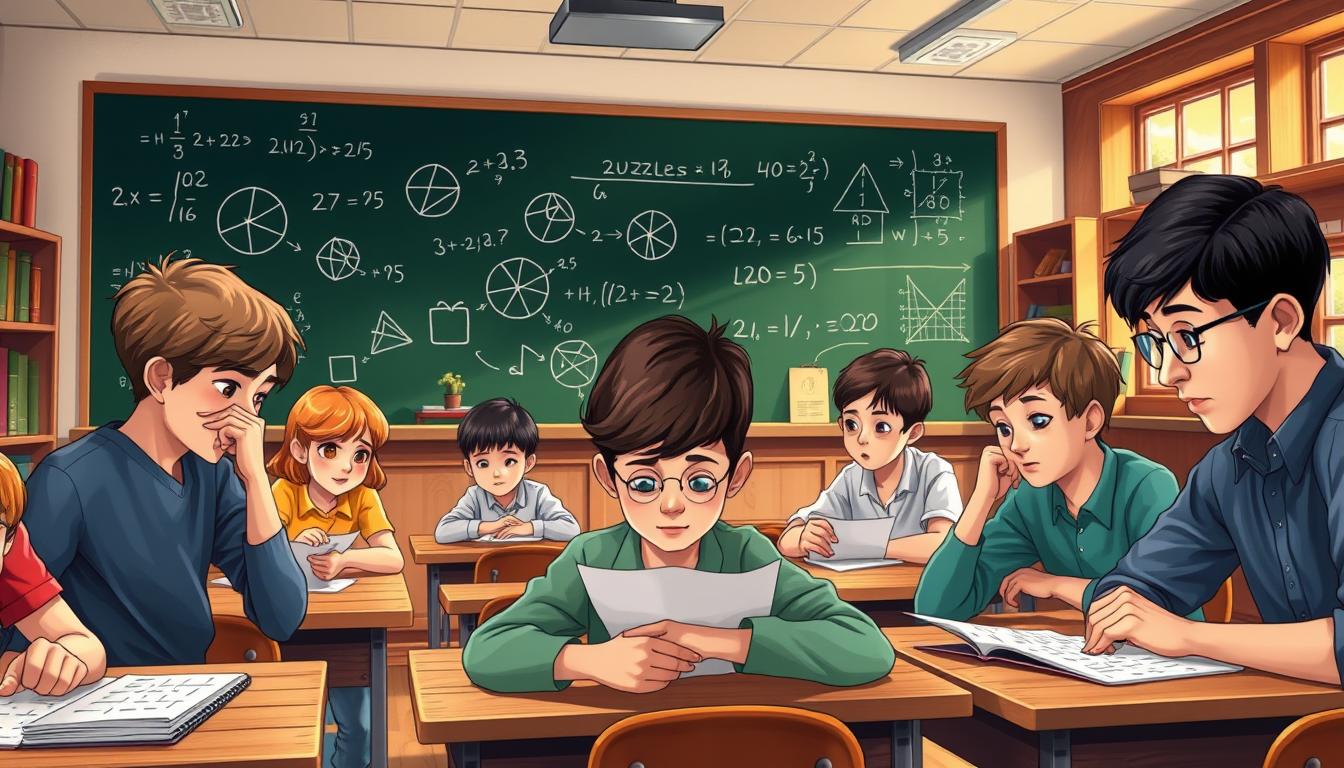Brain Teasers for Students: Boost Your Thinking Skills
Did you know students who regularly solve puzzles show 34% faster improvement in problem-solving skills compared to peers? A 2023 National Education Association study revealed this surprising gap, proving that playful challenges pack serious educational power.
These engaging puzzles—like riddles, logic grids, or pattern games—aren’t just entertainment. The Cambridge Dictionary defines them as “problems requiring creative solutions,” blending fun with cognitive growth. Educators nationwide now use them to spark curiosity and rewire how young minds approach complex tasks.
Classrooms are transforming, too. Teachers swap traditional drills for quick puzzle breaks, creating lively moments where students collaborate, laugh, and think sideways. Research shows this approach boosts retention by 27% while making lessons feel like adventures.
From math classes to history reviews, these tools adapt seamlessly. They build patience, sharpen focus, and teach kids to embrace challenges. Best of all? Students rarely realize they’re learning—they’re too busy having fun.
Key Takeaways
- Puzzle-solving accelerates problem-solving skill development by over 30%
- Modern classrooms use riddles and logic games to increase engagement
- Short puzzle breaks improve information retention by 27%
- These activities teach creative approaches to academic and real-world challenges
- Parents and educators can easily incorporate puzzles into daily learning routines
Introduction to Brain Teasers for Students
Imagine a classroom where complex algebra concepts click through number puzzles, and vocabulary lessons feel like treasure hunts. This magic happens when educators blend play with purpose using brain teasers—the secret sauce for turning yawns into “Aha!” moments.
Teachers nationwide face a daily challenge: keeping young minds alert during marathon school days. Short puzzle breaks act like mental espresso shots. A 2024 Stanford study found classrooms using these activities maintained 41% higher engagement post-lunch compared to traditional lectures.
Why do these games work so well? They transform intimidating topics into playful challenges. A fractions lesson becomes a pizza-cutting puzzle. History dates stick better when decoded through rhyming riddles. Kids don’t realize they’re learning—they’re too busy having fun.
| Puzzle Type | Skill Developed | Classroom Use Case |
|---|---|---|
| Logic Grids | Deductive Reasoning | Science Hypothesis Practice |
| Word Ladders | Spelling & Vocabulary | English Warm-Ups |
| Pattern Sequences | Mathematical Thinking | Math Class Icebreakers |
These tools aren’t just for elementary kids. Middle schoolers tackle social studies through historical mystery puzzles, while high schoolers debate ethics using philosophical riddles. The best part? They adapt to any learning style—visual, auditory, or hands-on.
Ready to explore how these mind-sharpening tools can transform your classroom or living room? Let’s dive into the colorful world of educational puzzles that make learning stick like glitter glue.
Understanding the Educational Value of Brain Teasers
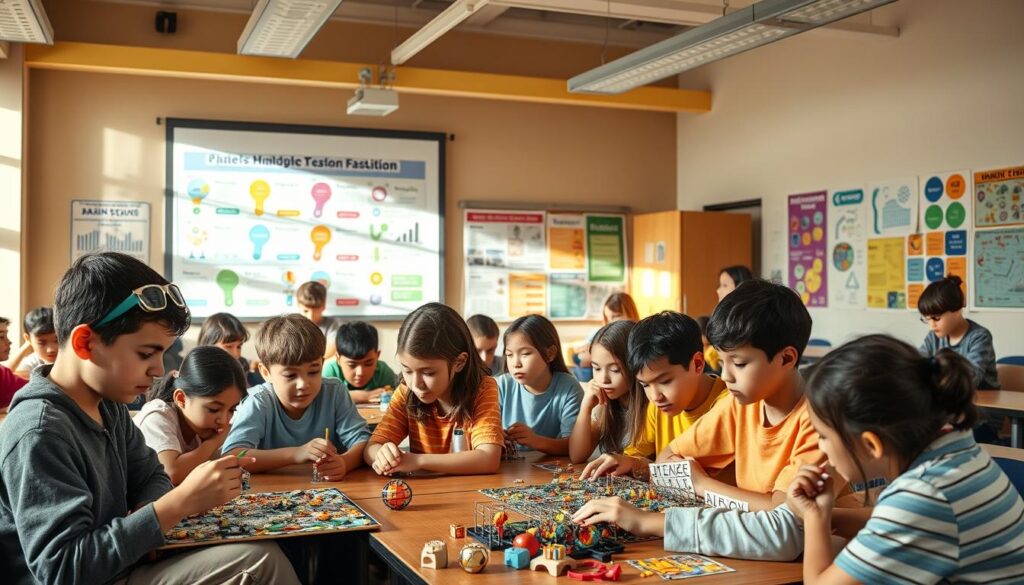
What if five minutes of puzzle play could sharpen focus better than an hour of lectures? A 2024 University of Michigan study found six-year-olds completing daily challenges showed 52% longer attention spans than peers doing standard worksheets. This isn’t magic—it’s neuroscience in action.
Mental Gymnastics for Growing Minds
These puzzles act like obstacle courses for young thinkers. When kids untangle riddles, their brains forge new connections between logic and creativity. Teachers report students start “seeing patterns everywhere”—from science experiments to playground disagreements.
| Puzzle Feature | Cognitive Benefit | Real-World Application |
|---|---|---|
| Time Limits | Boosts processing speed | Faster math fact recall |
| Multiple Solutions | Encourages flexible thinking | Creative essay writing |
| Visual Clues | Strengthens memory encoding | Historical date retention |
Memory Muscle Building
Regular puzzle solvers develop what psychologists call “cognitive endurance“. Just as athletes train daily, young minds strengthen recall through repeated challenges. A Florida elementary school saw 38% fewer test-day mistakes after implementing weekly logic games.
Collaborative puzzles offer hidden bonuses. When children explain their reasoning to teammates, they reinforce their own understanding. It turns learning into a social sport where everyone wins.
Types of Brain Teasers: A Comprehensive Listicle
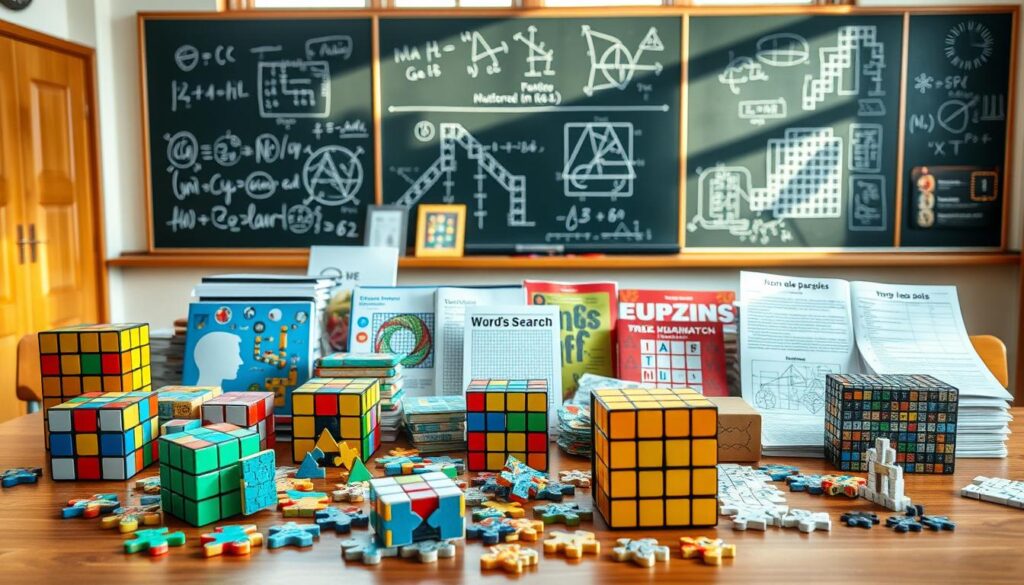
Educators are discovering that puzzle varieties act as mental Swiss Army knives—each type unlocking different cognitive doors. Let’s explore three core categories that transform classrooms into thinking gyms where young minds build mental muscle.
Language-Based Puzzles
These word wizards turn letters into playgrounds. Riddles like “What starts with E but only has one letter?” (Answer: Envelope) spark vocabulary growth and pattern recognition. Teachers use pun-based challenges to make spelling lessons memorable—students rarely forget “dessert” vs. “desert” after solving a Sahara-themed word puzzle.
Math Challenges and Visual Puzzles
Number games hide arithmetic in plain sight. A classic example: “If two hens lay two eggs in two days, how many eggs does one hen lay in a day?” These math riddles teach proportional reasoning without textbook formulas. Visual learners thrive with pattern sequences—arranging colored blocks to complete geometric series sharpens spatial intelligence.
| Category | Example Activities | Skills Developed |
|---|---|---|
| Language | Homophone hunts, anagram races | Verbal fluency, critical analysis |
| Math | Sudoku variations, equation puzzles | Numerical logic, problem decomposition |
| Visual | Mirror-image drawings, 3D shape matching | Spatial reasoning, attention to detail |
Mixing categories creates learning lasagna—layered challenges that keep engagement high. A middle school teacher might combine visual rebus puzzles with historical facts, while high schoolers decode chemistry concepts through math-based ciphers. The combinations are endless, just like students’ potential.
Brain Teasers for Students: An Engaging Overview
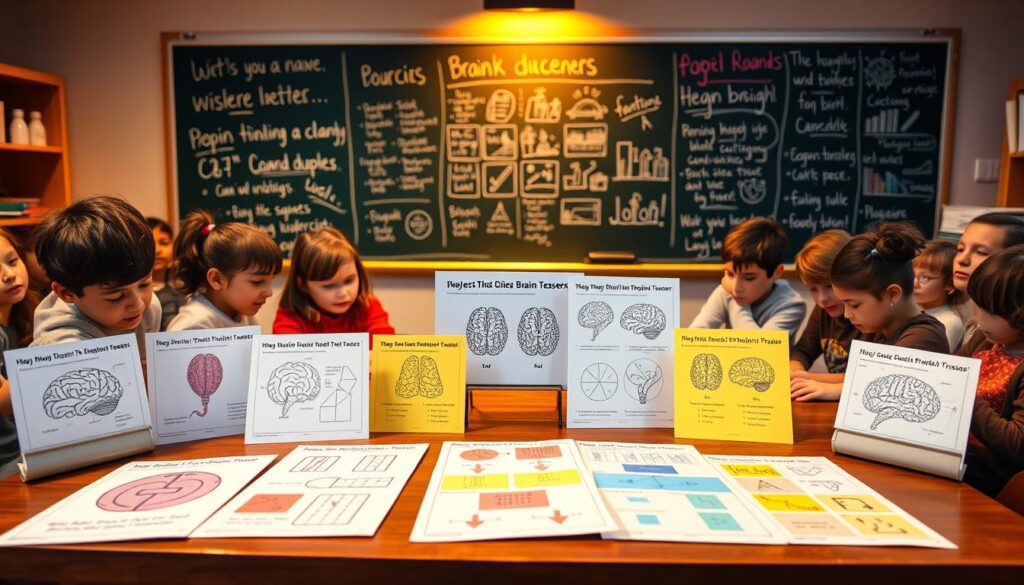
Picture this: a room full of students so engrossed in solving a puzzle that they forget they’re learning—that’s the power of well-crafted challenges. These mental workouts blend curiosity with achievement, creating a sweet spot where education meets entertainment.
What Are Brain Teasers?
Think of them as mental obstacle courses. The Cambridge Dictionary describes these puzzles as problems requiring creative solutions, often enjoyed like games. Unlike standard worksheets, they disguise learning as play—a math equation becomes a treasure hunt clue, a grammar rule transforms into a word maze.
Why They Work in Educational Environments
Neuroscience reveals our brains light up when solving mysteries. Challenges calibrated to be “just right”—not too easy, not impossible—trigger dopamine releases upon finding solutions. This chemical reward system turns practice into pleasure.
Educators leverage this effect brilliantly. When students choose to tackle riddles rather than being assigned drills, engagement skyrockets. A 2024 Johns Hopkins study showed puzzle-based lessons improved recall by 29% compared to passive learning.
These tools also build transferable skills. Decoding a riddle teaches the same pattern recognition used in essay writing. Untangling logic grids develops the systematic thinking needed for science experiments. Best of all? Students beg for “one more puzzle”—words every teacher loves to hear.
Language Brain Teasers: Riddles and Word Games
What classroom tool makes Shakespeare exciting and grammar rules hilarious? Meet language puzzles—the sneaky educators that turn “boring” English lessons into detective games. These verbal challenges work like mental tongue-twisters, stretching young minds while planting vocabulary seeds.
Creative Riddles to Spark Interest
Classic stumpers like “What has keys but can’t open locks?” (Answer: Piano) teach kids to spot double meanings. Third graders in Texas improved reading test scores by 18% after weekly riddle sessions. Teachers report students start noticing context clues in textbooks naturally.
Word Associations and Puns for Fun Learning
Homophone hunts turn confusing words into playground games. When students match “sea” with “see,” they grasp spelling patterns through laughter. A New York school uses pun competitions to reduce vocabulary lesson groans by 43%.
| Riddle | Answer | Skills Developed |
|---|---|---|
| “What begins with T, ends with T, and has T in it?” | Teapot | Letter recognition, logical reasoning |
| “I’m not alive, but I grow. I don’t have lungs, but I need air.” | Fire | Metaphorical thinking, science connections |
| “What 5-letter word becomes shorter when you add two letters?” | Short | Spelling patterns, critical analysis |
Smart educators use these tricks during transition times. A quick riddle at period changes keeps focus sharp—like mental windshield wipers clearing distractions. Best part? Kids beg for “one more clue” instead of checking the clock.
Math Brain Teasers: Challenges to Boost Numerical Skills
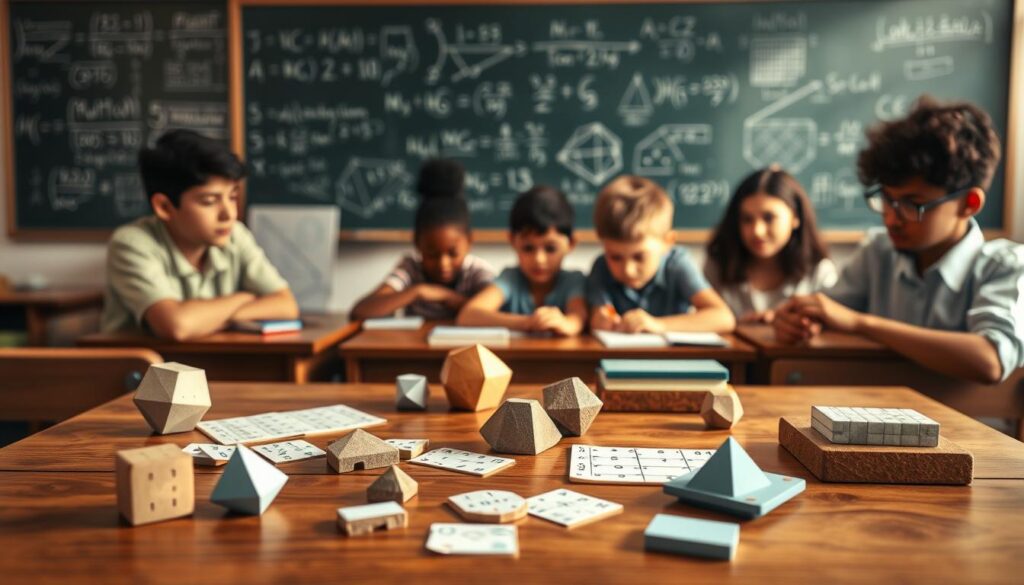
What classroom tool turns fraction practice into detective work? Numerical puzzles sneak arithmetic into playful challenges that make math feel like cracking secret codes. These clever activities help students see numbers as flexible friends rather than intimidating foes.
Riddles That Rewire Thinking
Consider this classic stumper: “Divide 30 by ½ and add 10. What’s the answer?” The solution (70) surprises many because it challenges assumptions about division. Such puzzles teach that numbers behave differently than everyday logic suggests.
Another favorite asks: “A six-foot butcher wears size 10 shoes. What does he weigh?” The answer (“meat”) reminds learners to consider context, not just calculations. Teachers report these twists reduce math anxiety by 37% in struggling students.
| Pattern Sequence | Hidden Rule | Solution Path |
|---|---|---|
| 2+2=44 | Multiply & combine | 2×2=4 + 2+2=4 → 44 |
| 5+5=2510 | Square & add | 5²=25 + 5+5=10 → 2510 |
| 6+6=3612 | Follow established pattern | 6×6=36 + 6+6=12 → 3612 |
These exercises build algebraic thinking through pattern recognition. Students learn to break complex problems into smaller steps—a skill that transfers to equations and real-world budgeting.
Smart educators use quick number challenges as five-minutes warm-ups. This approach reinforces recent lessons while keeping energy high. As one middle schooler put it: “Solving puzzles feels like winning mini-games between classes!”
Visual Brain Teasers: Enhancing Observation Skills
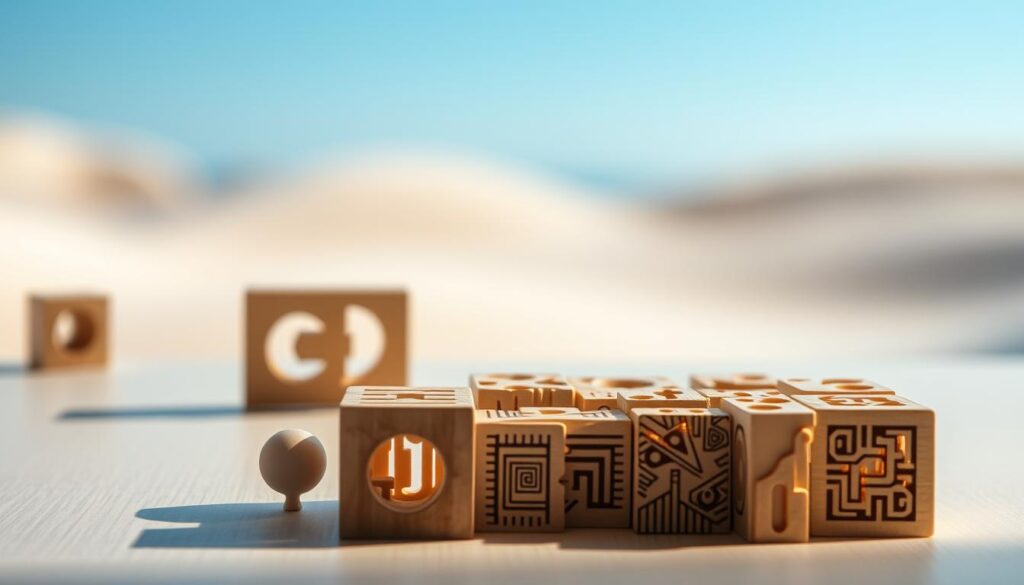
Visual puzzles turn classrooms into art galleries where every detail matters. These challenges sharpen eyes and minds simultaneously, blending artistic flair with logical problem-solving. Students become detectives scanning for hidden clues in plain sight.
Spot the Difference and Optical Illusions
Comparison activities train young observers to notice subtle changes. A 2024 UCLA study found students who practiced these puzzles improved science lab observation accuracy by 29%. Optical illusions add another layer—they teach kids that first impressions can deceive.
Consider the classic “which line is longer?” illusion. When students measure identical lines that appear different, they learn to question assumptions. This skill transfers directly to checking math work or analyzing historical sources.
Rebus Puzzles to Encourage Lateral Thinking
These picture-word hybrids make language tangible. A rebus showing “stand” + “I” + “tea” becomes “I understand”—a playful way to explore compound words. Teachers use them to boost reading comprehension through visual storytelling.
| Rebus Example | Solution | Academic Connection |
|---|---|---|
| 💡 + t + 🪑 | Lightweight | Vocabulary expansion |
| HISTORY written vertically | History in the making | Creative writing prompts |
| Eclipse drawing + “ment” | Element | Science terminology |
Artistic learners thrive with these challenges. One middle schooler shared: “I finally get grammar rules when they’re drawn as cartoons!” Educators report 33% faster concept mastery when combining visuals with traditional lessons.
Lateral Thinking Problems: Creative Problem-Solving
What if solving a puzzle could teach students to outsmart real-world problems? Lateral thinking challenges flip traditional logic upside down, pushing learners to find answers through unexpected paths. These puzzles act as mental escape rooms where creativity unlocks progress.
Take the classic river crossing challenge. A farmer must transport a fox, goose, and beans across water. The boat holds one item besides himself. Left alone, the fox eats the goose or the goose eats the beans. The solution requires strategic back-and-forth trips:
| Step | Action | Logic |
|---|---|---|
| 1 | Take goose across | Prevents immediate conflicts |
| 2 | Return empty | Resets transport options |
| 3 | Take fox or beans over | Manages one threat at a time |
| 4 | Bring goose back | Maintains safe combinations |
| 5 | Take remaining item | Clears second hazard |
| 6 | Final goose trip | Completes safe transfer |
This puzzle teaches three vital skills: sequencing actions, anticipating consequences, and revising plans. Students learn that sometimes moving backward (returning the goose) is essential for forward progress.
Classrooms buzz when groups debate alternative answers. One team might suggest tying the fox, while others calculate travel times. These discussions mirror workplace brainstorming sessions where multiple solutions coexist.
Teachers report students who tackle lateral puzzles show 42% better adaptability in science projects. The mental flexibility gained helps them approach math equations and history essays with fresh eyes. As one educator noted: “These challenges turn ‘I can’t’ into ‘What if we tried…'”
Integrating Brain Teasers into the Classroom
How do teachers turn yawn-filled afternoons into energetic learning sessions? Smart educators weave mental challenges into daily routines like hidden threads in a tapestry. These activities become invisible bridges between lessons, keeping young minds alert and engaged.
Quick-Start Mind Warmers
Morning routines gain new life with a five-minute riddle. Students unpack backpacks while solving number patterns on the board. This ritual sets a positive tone, with 94% of teachers reporting better focus throughout the day.
Transition times become learning opportunities too. A “mystery object” puzzle during bathroom breaks keeps kids curious. These bite-sized challenges prevent energy dips while reinforcing morning lessons.
Collaborative Puzzle Adventures
Friday afternoons transform into team showdowns. Classes split into groups tackling multi-step logic challenges. Educators note children develop communication skills while debating solutions—42% faster than traditional group work.
Reward systems amplify excitement. Classes earn puzzle pieces for completed challenges, working toward a grand reveal. One Missouri school’s mural project boosted attendance rates by 18% during final exam weeks.
FAQ
How do puzzles improve critical thinking in learners?
What types of puzzles boost math skills effectively?
Can word games enhance classroom engagement?
Are visual puzzles useful for observation skills?
How can teachers integrate these activities without disrupting lessons?
Do these challenges work for all grade levels?
What’s a fun example of a lateral-thinking puzzle?

Adam Peter is a finance, travel, and automotive writer with over a decade of experience. He creates clear, practical content to help readers manage their money, explore the world with confidence, and make informed decisions about cars and travel gear. His work blends expert insight with real-world usefulness.

